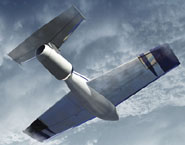It isn't excluded that in the near future there will be first light planes on almost silent and environmentally friendly jet draft.


Researchers from Massachusetts Institute of Technology (MIT) carried out a series of calculations and experiments and found out that atmospheric ionic engines can be much more effective, than was considered earlier.
Actually the phenomenon of electrohydrodynamic draft or simply an ionic wind was open in 1960. Its essence in the following: when current passes between two electrodes one of which is thinner, than another, the air stream is created. If a tax on conductors sufficient tension, it is possible to receive very powerful air stream which will be to hold the plane in air enough.
Unfortunately this, undoubtedly, attractive type of the jet engine long time remained an entertainment for engineers and conjurers as was considered insufficiently powerful a share of creation of "serious" jet draft. Some scientists assumed that atmospheric ionic jet engines are extremely inefficient: demand a huge number of the electric power at not so big draft.
Nevertheless, calculations and experiments of experts of MIT showed that in certain conditions ionic engines can be much more effective source of draft, than ordinary jet engines. In the experiments they found out that the ionic wind can give out to 110 newtons of draft on kilowatt, in comparison with 2 newtons on kilowatt at the ordinary jet engine. Thus the ionic wind effectively to be used on some types of aircraft, first of all on small light planes. Thus ionic engines are almost silent and invisible in the infrared range as don't allocate huge quantity of heat as the traditional jet.
In MIT developed basic design of the effective ionic engine. Installation for production of an ionic wind consists of three parts: very thin copper electrode (issuer), thick tube from aluminum (collector) and an air gap between them. All design is collected on an easy frame in which wires for connection of a collector and the issuer to power supply source are laid. When giving tension the gradient of a field "pulls out" electrons from the next molecules of air and the ionized molecules strongly makes a start from the issuer and are attracted to a collector. Thus the cloud of ions takes surrounding neutral molecules of air and creates jet draft.
It is interesting that the ionic engine showed the greatest efficiency at a low speed of an air stream. In other words, it is better to use an ionic wind for slow movement of a large amount of air, instead of to disperse small volumes to supersonic speeds. It means that most optimum to apply the ionic engine by slow planes at which air inlets for an ionic wind will actually settle down on all surface. It suggests at once an idea of hardly noticeable pilotless scout planes with big wingspan.
It should be noted that calculations of MIT show high requirements of the ionic engine to tension: the small plane requires a power source which is giving out hundreds or even thousands kilovolts. Tension has to be huge, but in MIT believes that they can be received from extralight solar panels and fuel elements.
No comments:
Post a Comment